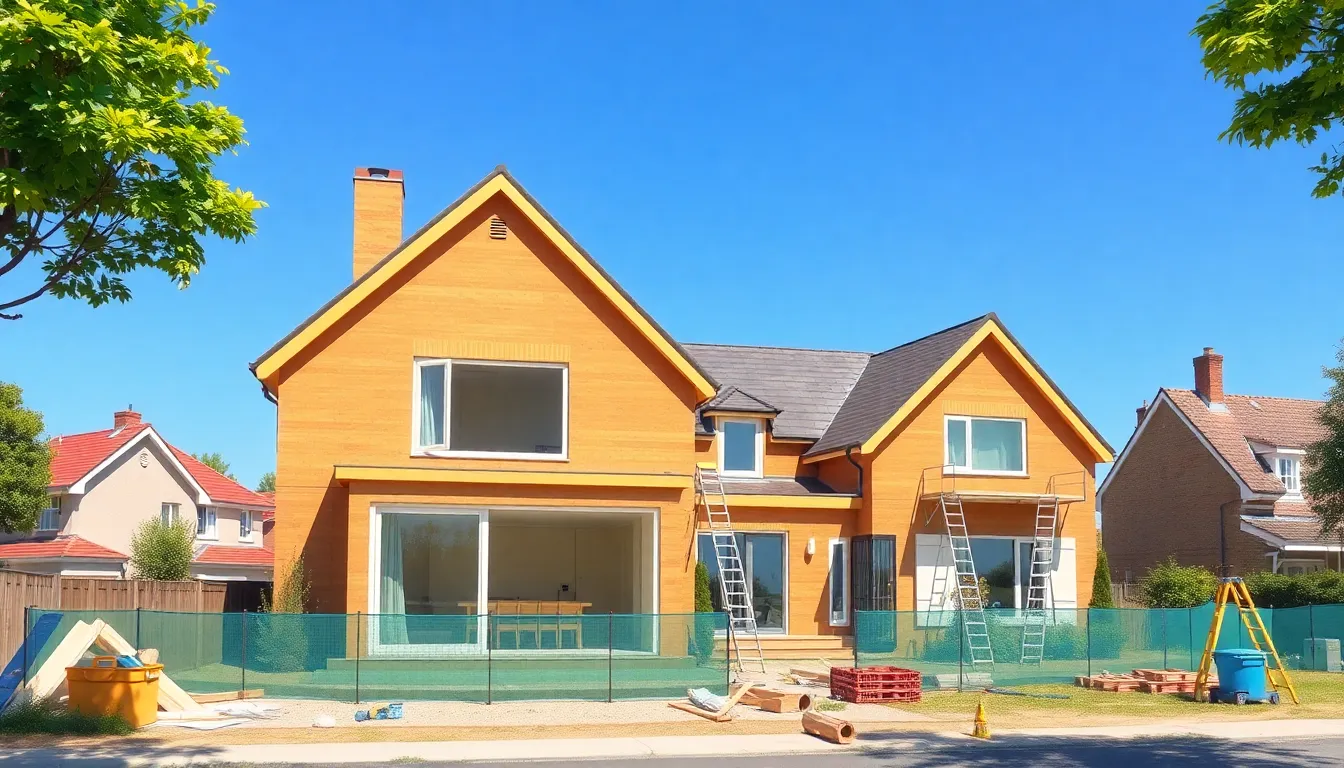Thinking about adding a little extra space to your home? You’re not alone. Home extensions are like the adult version of getting a new toy—only this time, it comes with a hefty price tag. Before diving headfirst into the world of construction, it’s crucial to understand the costs involved. After all, nobody wants to be that person who accidentally turns their dream project into a financial nightmare.
Home Extension Cost
Home extensions can significantly enhance living space and property value. Understanding costs is crucial to manage budgets effectively.
Factors Influencing Cost
Location plays a major role in determining expenses. Urban areas often have higher costs than rural locations. The size of the extension also affects pricing; larger projects incur more significant costs. Materials chosen will impact the overall budget. Expensive materials, like natural stone, will raise the total. Labor costs vary based on the expertise of contractors involved. Complex designs typically require more skilled labor, increasing expenses. Permits and regulations may impose additional fees. Homeowners should budget for unexpected costs that might arise.
Average Cost Breakdown
Average costs for home extensions in the U.S. range from $100 to $400 per square foot. Kitchen extensions can cost between $80,000 and $200,000, depending on size and materials. Bathroom extensions typically range from $30,000 to $70,000. Living room extensions average $50,000 to $150,000. Additional factors such as plumbing and electrical work could add $15,000 to $25,000. Costs for permits and inspections usually range from $1,000 to $5,000, depending on local regulations. Homeowners should prepare for at least a 10% contingency budget for unplanned expenses.
Types of Home Extensions

Home extensions come in various forms, each serving distinct purposes and offering unique advantages. Knowing the options helps homeowners choose the right style that fits their needs.
Single-Story Extensions
Single-story extensions add horizontal space to a property, often optimizing a building’s layout. This type frequently serves as a new living room, kitchen, or expanded dining area. Costs for single-story extensions typically range from $100 to $300 per square foot, depending on location, materials, and design choices. Many homeowners prefer this extension to enhance outdoor flow or create a brighter atmosphere with the addition of large windows. Building permits must be considered, as guidelines differ by municipality.
Double-Story Extensions
Double-story extensions increase both vertical and functional space within a home. These enhancements may create additional bedrooms or bathrooms, significantly boosting property value. Average costs for double-story extensions generally fall between $150 and $400 per square foot. Homeowners can expect this option to be a more expensive investment due to the complexity of construction. Structural reinforcement requirements also influence costs and planning. Local zoning laws and building codes impact permitting processes, thus understanding these regulations remains essential during planning.
Budgeting for Your Home Extension
Budgeting effectively for a home extension requires careful planning and consideration of various components. Accurate estimates play a crucial role in avoiding financial pitfalls and ensuring project success.
Setting a Realistic Budget
Setting a realistic budget involves several key factors. Start by determining the total square footage of the planned extension, considering average costs between $100 and $400 per square foot. Include additional expenses for materials and labor, as prices vary significantly depending on quality. Local labor rates might influence overall costs. It’s vital to engage with contractors early to receive detailed quotes aligned with specific design plans. By prioritizing needs over wants, homeowners can allocate funds more efficiently, reducing unnecessary expenditures. Establishing a contingency fund of at least 10% helps cover unexpected costs that may arise during construction.
Hidden Costs to Consider
Hidden costs can significantly impact the overall budget for a home extension. Homeowners should consider expenses associated with permits, inspections, and other regulatory fees, which might vary based on local building codes. Utility upgrades often arise as a project progresses, particularly when adding new rooms that require additional power or plumbing. Furniture and decor for newly added spaces add to the financial obligation and can easily exceed initial estimates. Landscaping and exterior modifications can further inflate costs, especially in areas where outdoor aesthetics are prioritized. Planning for these hidden costs ensures homeowners avoid unpleasant surprises throughout the extension process.
Financing Options for Home Extensions
Homeowners often explore various financing options to fund their home extension projects. Understanding these avenues can ease the financial burden of an extension.
Home Equity Loans
Home equity loans provide a viable financing solution for many homeowners. With this option, individuals borrow against the equity they’ve built in their property. Typically, lenders offer amounts up to 80% of a home’s equity. Fixed interest rates generally accompany these loans, making budgeting simpler. Payments stay consistent throughout the loan term, aiding in financial planning. Approvals usually depend on the homeowner’s credit score and overall financial health. This option helps manage larger expenses associated with home extensions, like construction and material costs.
Personal Loans
Personal loans serve as another effective means to finance home extensions. These unsecured loans don’t require collateral, providing flexibility for homeowners. Lenders often offer personal loans with fixed interest rates and terms ranging from 2 to 7 years. Borrowing amounts typically range between $1,000 and $50,000, catering to various budget sizes. Individuals with good credit score usually secure lower interest rates. Quick funding also makes personal loans appealing for those needing immediate financing for their projects. Homeowners can use these funds for both expected and unexpected extension costs.
Conclusion
Understanding the costs associated with home extensions is vital for homeowners looking to enhance their living space without financial strain. By carefully assessing factors like location size and materials, they can create a realistic budget that accommodates both expected and unforeseen expenses. Setting aside a contingency fund is essential for navigating any surprises that may arise during the project.
With the right planning and financing options, homeowners can transform their properties into dream spaces while maintaining financial stability. Ultimately, a well-executed home extension not only improves daily living but also adds significant value to the property.



